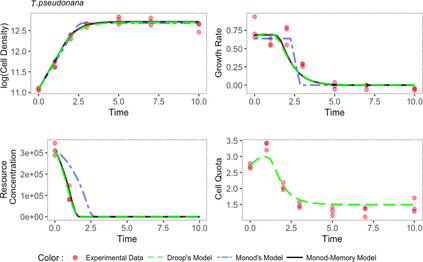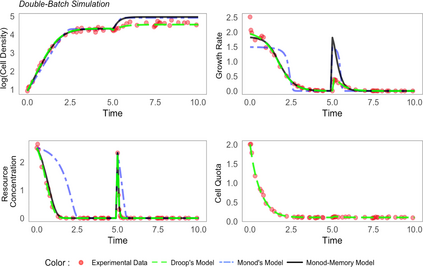Monod's model describes the growth of microorganisms using a hyperbolic function of extracellular resource concentration. Under fluctuating or limited resource concentrations this model performs poorly against experimental data, motivating the more complex Droop model with a time-varying internal storage pool. We extend the Monod model to incorporate memory of past conditions, adding a single parameter motivated by a fractional calculus analysis. We show how to interpret the memory element in a biological context and describe its connection to a resource storage pool. Under nitrogen starvation at non-equilibrium conditions, we validate the model with simulations and empirical data obtained from lab cultures of diatoms (T. pseudonana and T. weissflogii) and prasinophytes (Micromonas sp. and O. tauri), globally influential phytoplankton taxa. Using statistical analysis, we show that our Monod-memory model estimates the growth rate, cell density, and resource concentration as well as the Droop model while requiring one less state variable. Our simple model may improve descriptions of phytoplankton dynamics in complex earth system models at a lower computational cost than is presently achievable.
翻译:Monod 模型描述微生物利用细胞外资源浓度的超偏移功能而生长的微生物。 在这种模型与实验数据相比变化不定或有限的资源浓度下,该模型运行不良,它激励着更复杂的Droop模型,并有一个时间变化的内部储存库。我们扩展了单项模型,以包含过去条件的记忆,增加了一个由分微微积分分析驱动的单一参数。我们展示了如何在生物背景下解释记忆元素,并描述其与资源储存库的联系。在非平衡条件下氮饥饿的情况下,我们用模拟和实验性数据来验证该模型,从对地原子(T.伪诺纳和T. Weisflogii)和prasinophytes(Micromonas sp. and O. tauri)的实验室文化中获取的经验数据。我们利用统计分析,显示我们的单项模型估计了生长速率、细胞密度和资源浓度以及Droop 模型,同时要求一个较低的状态变量。我们简单的模型可以改进在低计算成本的复杂地球系统模型中对植物浮游生物动态的描述。









